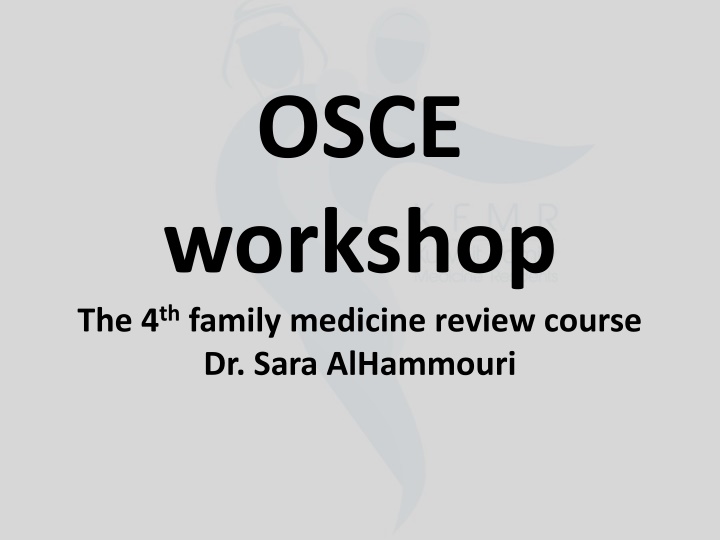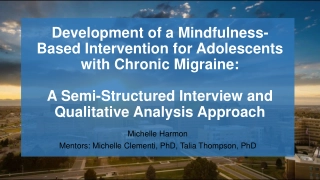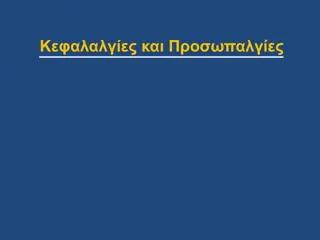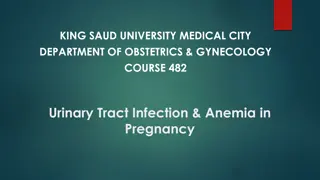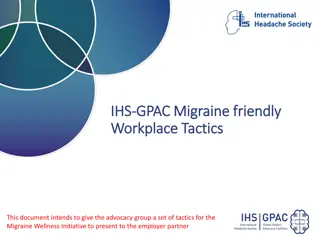Managing Migraine and Anticonvulsants in Pregnancy: Clinical Guidance
Learn how to effectively manage migraine headaches and administer anticonvulsants during pregnancy, with insights into symptom recognition, prophylactic treatments, medication safety, and counseling on endocrine disorders like diabetes mellitus and thyroid diseases. Stay informed on teratogenic effects of antiepileptic drugs and the importance of folic acid supplementation in pre-pregnancy care.
Download Presentation

Please find below an Image/Link to download the presentation.
The content on the website is provided AS IS for your information and personal use only. It may not be sold, licensed, or shared on other websites without obtaining consent from the author.If you encounter any issues during the download, it is possible that the publisher has removed the file from their server.
You are allowed to download the files provided on this website for personal or commercial use, subject to the condition that they are used lawfully. All files are the property of their respective owners.
The content on the website is provided AS IS for your information and personal use only. It may not be sold, licensed, or shared on other websites without obtaining consent from the author.
E N D
Presentation Transcript
OSCE workshop The 4thfamily medicine review course Dr. Sara AlHammouri
Counseling Neurology 1. Headache. 2. Anticonvulsants (breast feeding/pregnancy).
Headache You may get a patient with migraine and you will be asked to manage and start prophylactic medications. Know the symptoms of migraine headache. Red flags. Indications for prophylactic treatment. Pharmacological vs. non pharmacological management (acute, prophylaxis, life style advice, headache diary) Containdications Passmedicine
Anticonvulsants (breast feeding/pregnancy) Aim for monotherapy. No indication to monitor antiepileptic drug levels. Stress that the danger of not taking the antiepileptic is more life threatening to the mother and baby than the drug itself. Breast feeding is generally considered safe for mothers taking antiepileptic with the possible exception of barbiturates. All women thinking about becoming pregnant should be advised to take folic acid 5mg per day before pregnancy to minimize the risk of neural tube defects.
Anticonvulsants (breast feeding/pregnancy) Medication Teratogenic effect Sodium valproate neural tube defects Carbamazepine least teratogenic of the older antiepileptic Phenytoin cleft palate given vitamin K in the last month of pregnancy to prevent clotting disorders in the newborn Lamotrigine dose may need to be increase in pregnancy
Counseling Endocrinology 1. Diabetes Mellitus ( follow up, prediabetes) 2. Thyroid diseases (hypothyroidism, subclinical hypothyroidism). mentioned in the Data station. will be
Prediabetes Screen asymptomatic adults for Diabetes mellitus if: 1. BMI 25 kg/m . 2. BMI 23 kg/m . (Asian American) 3. And one or more Risk Factor: a. Physical inactivity. b. 1stdegree relative with DM. c. High risk race/ethnicity. d. Women with GDM or delivered baby > 4kg. e. HDL < 0.9 mmol/l, TG > 2.8 mmol/l. f. HbA1c 5.7 or more, IFG or IGT. g. Conditions associated with insulin resistance (metabolic syndrome, obesity, pregnancy, stress, inactivity, steroids). CVD history. If no risk factor testing start at 45y. If normal, repeat every 3 years. If prediabetes, test yearly.
HbA1c 5.7 - 6.4 % Prediabetes Diagnosis IFG (impaired fasting glucose) 5.6 - 6.9 mmol/l IGT (impaired glucose tolerance) 2 hrs post glucose 75g OGTT 7.8 - 11 mmol/l
History Examination Investigation Hx of symptoms of hyperglycemia: - Polyuria - Polydipsia - Weight loss Annual HbA1c Hx of complications of DM: - Neuropathy - Stoke/TIA (weakness, speech..) - Heart failure (dyspnea, PND, lower limb edema) - Chest pain - Repeated infections - - - Fundoscopy (retinopathy) Blood pressure measurement. Foot examination. Urine microalbumin (nephropathy) Risk factors: - Smoking - Obesity - Hyperlipidemia - Prior GDM (female) - Family history of premature CVD death < 55y m and <65 f. - Physical inactivity /Diet history. - - BMI. Waist circumference. Lipid profile
Management R complications. And it is not diabetes A Advice: 1. Diabetes self-management education (DSME): the ongoing process of facilitating the knowledge, skills and ability necessary for diabetes self-care. 2. Life style modification: 3. Weight loss: 7 % of body weight. 4. Increase physical activity: - 150 min/w moderate intensity exercise. - Spread over 3 d/w. - No more than 2 consecutive days without exercise. 5. Diet modification (Mediterranean diet recommended): - High in fruits/vegetables/whole grains/beans/nuts/seeds/olive oil) - Low to moderate fish/poultry/dairy products) - Low red meat. 6. Screening and treatment of modifiable CVD risk factors (obesity/ hyperlipidemia/ HTN/smoking) Reassurethe patient that this condition if managed can delay the onset of DM and prevent the
P Prescribe Metformin 850mg bd (Diabetes prevention program trial) for the following patients: BMI 35 kg/m or more. Age < 60 y. Women with prior GDM. (Start metformin 500mg for not less than 2 weeks then increase the dose to bd to avoid GI side effect). R Referral needed for dietician if necessary. I Investigations (yearly HbA1c and Lipid profile). O Follow up counseling is important for successful management (at least every 2 months)
Counseling Pediatrics: 1. Nocturnal enuresis. 2. Constipation. 3. Toilet training. 4. Head lice. 5. Febrile convulsions. 6. Breast feeding and weaning. 7. ADHD 8. Down syndrome
Nocturnal enuresis Management - < 7y no need for treatment (nappy alarm) - > 7y refer to enuresis clinic. (Desmopressin). resolve spontaneously. NICE advise: 'Consider whether alarm or drug treatment is appropriate, depending on the age, maturity and abilities of the child or young person, the frequency of bedwetting and the motivation and needs of the family'. Generally: anuresis alarm is first-line for children under the age of 7 years Desmopressin may be used first-line for children over the age of 7 years, particularly if short-term control is needed or an enuresis alarm has been ineffective/is not acceptable to the family
Management RAPRIOP: - R reassurance that the problem is not their fault. - Explain causes 1. Delay in maturation (resolve with time). 2. 1-2% have physical abnormality (UTI). 3. Congenital anomalies/sacral nerve disorders/DM/Diabetes insipidus/pelvic mass. 4. Emotional distress (dry reassure the child and parents wetting bed).
Affects 30% 6 year old 10% 10 year old 3% 12 year old 1% 18 year old Runs in families.
A advice - advise on fluid intake, diet and toileting behavior - Avoid fluids before 1 h of bed time. - Urinate before going to bed. - Record wet-dry nights. - Star charts reward systems . NICE recommend these 'should be given for agreed behavior rather than dry nights e.g. Using the toilet to pass urine before sleep
P prescription: 1. enuresis alarm: First few weeks, the child wakes after complete emptying. Next few weeks, partial inhibition. Wake up before the bladder empty in response to contraction. Should be used for at least 3 weeks, and until dry for 2 weeks. 70% effective, relapse in 10-15%.
P prescription: 2. Desmopressin Synthetic version of antiduiretic hormone. Tablet (taken at night) SE: headache, nausea, nasal congestion, nosebleed, sore throat, cough, flushing, mild abdominal cramps. May cause water overload and after 8 hrs of taking. To cover holidays (short term effectiveness 4-6w). no water before 1 hr
P prescription 3. Anticholinergics/TCAs : Do not use tricyclics as the first-line treatment Consider imipramine for children and young people with bedwetting who have not responded to all other treatments Consider an anticholinergic combined with desmopressin for children and young people that has not responded to an alarm and/or desmopressin
R no need for referral unless there is physical problem that need to be treated or investigated by pediatrician. I urinalysis, FBS. O can be seen after 2 or 4 weeks to see response according to type of treatment.
Toilet training Children should be without nappies by day 3 y. By night 2-5 y. General rules: - Wait until child is ready. - Pick a good time (not timing of going to school). - Until child + parents are confident about child s ability to use toilet, continue using nappies when out and at night. 2-
Constipation Diagnose constipation if 2 of: 1. Abnormal stool pattern: (<3 stool per wk, hard or rabbit dropping stool, overflow soiling) 2. Symptoms associated with defecation: (straining, poor appetite, abdominal pain) 3. History of previous constipation or anal fissure
Constipation Management: Explain: The frequency at which children open their bowels varies widely, but generally decreases with age from a mean of 3 times per day for infants under 6 months old to once a day after 3 years of age.
Constipation The majority of children have no identifiable cause - idiopathic constipation. Other causes of constipation in children include: dehydration low-fibre diet medications: e.g. Opiates anal fissure over-enthusiastic potty training hypothyroidism Hirschsprung's disease hypercalcaemia learning disabilities
Constipation Comprehensive program, including use of laxative, behavior changes and dietary changes. A advice (increase fluid intake, increase fiber rich diet) P prescribe There are 4 general steps: 1. Disimpaction (constipation with fecal incontinence, stool mass palpable on DR, abdominal examination or xray, hx of incomplete or infrequent evacuation) 2. Prolonged laxative treatment and behavior therapy to achieve regular evacuation and avoid recurrent constipation. 3. Dietary changes (primarily increasing fiber content) to maintain soft stools. 4. Gradual tapering and withdrawal laxatives as tolerated. R refer : If not controlled.
The goal of therapy is the passage of soft stools, ideally once per day, and no less than every other day.
Encopresis Encopresis : Fecal soiling occur during the day. 1. If child has bowel control but passes stool in unacceptable places psychiatry. 2. If a firm stool is passed occasionally in the toilet but usually in the pants developmental delay (mental/social) firm consistent training program similar to motivational counseling for enuresis. 3. If soft stool oozes out causing the child to constantly soil himself and smell faeces consider overflow incontinence secondary to chronic constipation. Treat constipation refer if not settling. emotional Refer for child
Head lice Management RAPRIOP R reassurance / E explain Head lice (also known as pediculosis capitis or 'nits') is a common condition in children caused by the parasitic insect Most common in children aged 4-11y (f > M). Infest clean as often as dirty hair. Spread by close head to head contact, it does not fly or jump. Present as itchy scalp, could be asymptomatic. A advice Household contacts should be examined and treated if infested Bedmates should be treated prophylactically. School exclusion is not advised for children with head lice (lice often are present for weeks prior to detection)
P Treatment is only indicated if living lice are found A choice of treatments should be offered: Dimeticone lotion or spray (rub into dry hair and scalp in evening, allow to dry naturally, then shampoo off the next morning, repeat after 7 days). Insecticides 4 types: malathion used with caution in pregnancy phenothrin/permethrin avoid in pregnancy(first line/second line) carbaryl is reserved for third line 2 applications 7 days apart Mechanical clearance wet-comb bug busters conditioned hair with fine tooth comb. Others methods electric comb, aromatherapy, herbals (no evidence). prescription 1. 2. - - - -
I investigations fine-toothed combing of wet or dry hair to visualize the lice and confirm diagnosis P prevention Detection combing Recommend school examination
Enterobiasis (pinworm) R reassurance and E explanaition - Autoinfection occurs by scratching the perianal area - Person to person transmission by hand. - Asymptomatic in most patients but the most common symptom is perianal itching, predominantly at night. - occasionally, abdominal pain, nausea and vomiting develop. Management RAPRIOP mouth. A advice - Hygiene - Simultaneous treatment of the entire household is warrented, given high transmission rates among families. P prescription Treatment with Abendazole, mebendazole or pyrantel promoate.
Mebendazole Adult dosing (pinworm infection): 100 mg PO as single dose If the patient is not curred 3 wk after treatment, a second course of treatment is advised. Adult dosing (whipworm, hookworm, roundworm infections): 100 mg PO bid x 3 days If the patient is not cured 3 wk after treatment, a second course of treatment is advised Pediatrics dosing (similar to adult dose) Safety and effectiveness in pediatric patients < 2 years of age have not been established.
R referral no need except if diagnosis tools needed. I investigations Diagnosis via examination of cellophane tape for eggs after pressing to the perianal skin. Stool examination is limited since worms and eggs are not generally passed in stool. O follow up after 3 weeks to check improvement and response to tretament.
Febrile convulsion Anxious father with his child who has febrile convulsion. Management RAPRIOP R reassurance and E explanation: - It is a convulsion associated with fever that are divided into simple and complex. - Common problem 4% in general population. - Between the age of 6m-6y - 2% chance of developing epilepsy which is the same as the general population. - Recurrence rate is 30-40%. - Genetic predisposition.
A advice - give antipyretic whenever the child is febrile - if the child is having a convulsion a. do not panic b. put him in lateral position c. if available give rectal diazepam if seizure did not stop after 5 min, if not aborted bring to nearest clinic and give another diazepam after 5 min. P prescription (antipyretic, rectal diazepam)
R referral refer if: 1. First febrile seizure. 2. Not assessed after the first seizure. 3. Uncertain diagnosis. 4. > 15 min, focal, recurred in the same illness or within 24 hrs or incomplete recovery. 5. Anxious parents although reassurance was given. 6. Suspected serious cause for the seizure.
Breast feeding/ weaning Recommendation is to exclusive breast feeding until the age of 6 months Feed on need. Signs of hunger (fuss, sucking, moving lips) No other fluids including water are recommended. Advantages to mother and child. Contraceptive method exclusively breast feeding for 6 months and amenorrhea. Vitamin D supplementation. Storage of breast milk (4 h room T, 48 h Fridge, 3 m Frozen). 1. 2. 3. 4. 5. 6. 7. Complementary feeding: Rice (fortified with iron) for 1 month. Vegetables (broccoli, pumpkin) high in vit A and iron. 2-3 tablespoons porridge or well mashed 2-3 X/d. At 8 m small chewable items. At 9 m start meat. 2-5 y as adult. Introduce each type at a time for 3-4 days.
